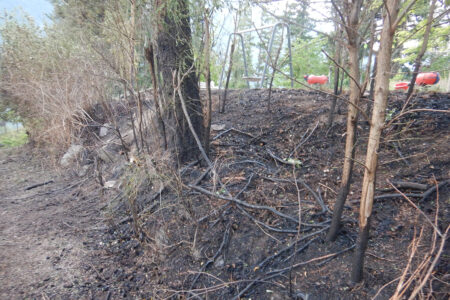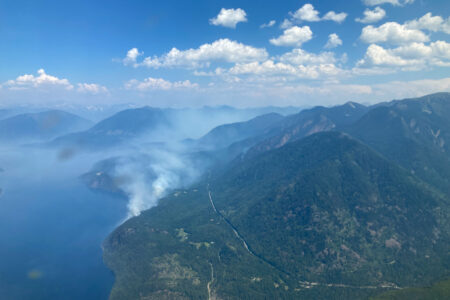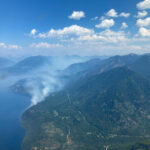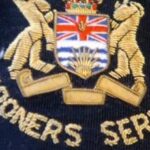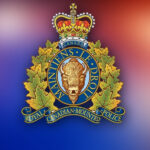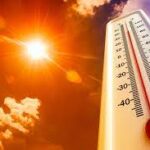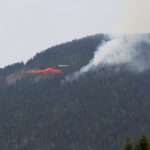Kokanee fish making a comeback in Christina Lake
When Brenda LaCroix, project manager for the Christina Lake Stewardship Society, watches an underwater video of the Kokanee salmon swimming in Sandner Creek she can’t help but feel optimistic.
Five years ago the wriggling, glinting red bodies of the Kokanee salmon were not so dense or plentiful in our waters. But thanks to nature and a vigilant eye, their numbers are on the rise.
“What happens to them happens to us,” said LaCroix, of why counting fish matters. “They are a base line indicator of the water quality and shoreline health.”
This year the Christina Lake Stewardship Society (CLSS) counted 15,210 Kokanee in Sandner Creek during their spawning season – up 13,000 from last year, which was at 2,000. The count is taken by volunteers during their spawning season on days between mid-August to mid-September.
There are two kinds of Kokanee in the lake, one spawns in the streams, the other spawns on the shoreline within the lake. Shore spawners are not included in the count because they spawn between mid-December and the end of January while the ice is on the lake, making it difficult to get those numbers. Although LaCroix is always experimenting with ways to get them.
The official fish count is determined by taking the highest number counted on any given day during the spawning season and multiplying that by 1.5 to get an estimate on the total population, said LaCroix.
In addition to Sandner Creek, Kokanee were also found in McCrae and Sutherland Creeks, which was a pleasant surprise for LaCroix. McCrae had 176 and Sutherland had 197. The spawning populations have been absent from those creeks for many years due to several natural events including a major debris torrent in 2006 from the Trans Canada Trail which left a lot of sediment behind. Both creeks also suffered from drought, making water levels either non-existent or not high enough for the spawning salmon to return to.
“Low precipitation in the summer left McCrea high and dry so there was no access (for the fish) for some time,” said LaCroix. “But the sediments are now clearing out and with the higher precipitation continuing on into July, the water in all the creeks was good this year.”
“We’re happy to see McCrae and Sutherland getting fish – they’re not back to original levels, but it shows Mother Nature is cleaning things up.”
Like everything in nature, Kokanee fish populations have their boom and bust years. The fish have a three and a half to four year lifecycle. After they spawn in their natal water, they die.
Despite the bust years of 2006, a special acoustic trawler surveyed the density of the fish population in Christina Lake and found there were 304 fish per hectare, which was double the density of Okanagan Lake.
The Kokanee is a freshwater sockeye salmon that never goes to the ocean. The stewardship society has been recording the fish populations for the past 12 years, before that the Ministry of Environment would sporadically do it, but much of that historical data is lost, said LaCroix. The society’s data is collected and given to the ministry for historical reference.
Kokanee found in Kettle River below Cascade Falls
For the first time, the stewardship society found Kokanee swimming in the deep pools found below Cascade Falls in the Kettle River.
“People have known for years there were Kokanee there but this is the first time we’ve seen or photographed them (during the count),” said LaCroix.
She said some of the pools are 16.45 meters or 54 feet deep, making it difficult to count the fish. By using an underwater camera, the volunteers could see the fish more clearly, confirming that the Kokanee are in the Kettle River.
LaCroix doesn’t know if the Kokanees in Kettle River originate from the Christina Lake crew or another source. They’ll have to catch some to have DNA testing done.
Shore spawning Kokanee need to matter to residents
Shore spawning Kokanee are in a precarious position due to the on-shore developments at the lake. People build their homes along the shore and then unknowing destroy the shore spawning sites by bringing in sand for their artificial beach or disturbing the lake bed, said LaCroix.
“Most people don’t know spawning happens in the winter in front of their homes because they aren’t there in the winter,” said LaCroix. “They could be modifying the substrate that disturbs the spawning materials.”
The stewardship society has been trying to map the known shore spawning locations and then educating the homeowners so they know not to disturb the habitat.
DNA analysis done on the two kinds of Kokanee fish determined the shore spawning Kokanee are native to Christina Lake, while the stream spawners were stocked as eggs by the government from Kootenay Lake in 1931, 1932, 1933 and a final 150,000 in 1940. Rainbow trout have also been historically introduced to the lake since 1914.
A commercial fishery harvested the shore spawning Kokanee from Christina Lake from the turn of the century until the 1960s by drag seine. According to the CLSS Fish Species report issued in 2009, 28,000 pounds (12,700 kilograms) of Kokanee were harvested from Christina Lake between 1898 and 1899.
Video Footage courtesy of Doug Shannon.



